Effective Supervision: Report on Early Years Settings and Practices
VerifiedAdded on 2022/08/12
|11
|3286
|20
Report
AI Summary
This report examines the critical importance of safe supervision in early years settings, emphasizing its legal basis following the Plymouth Review and the subsequent statutory framework. It delves into the benefits of professional supervision, including enhanced staff development, improved performance management, and the creation of a safe environment for both children and staff. The report explores various supervision models, such as professional and developmental models, and their impact on staff and organizational outcomes. It analyzes the influence of legislation, codes of practice, and performance indicators on effective supervision. Additionally, the report addresses power imbalances within supervisory relationships and provides strategies for managing conflicts. The report also discusses performance management cycles, performance indicators, and the importance of anti-oppressive practices within the context of professional supervision. This report highlights the significance of supervision in ensuring quality care, safeguarding children, and promoting continuous improvement in early childhood education.
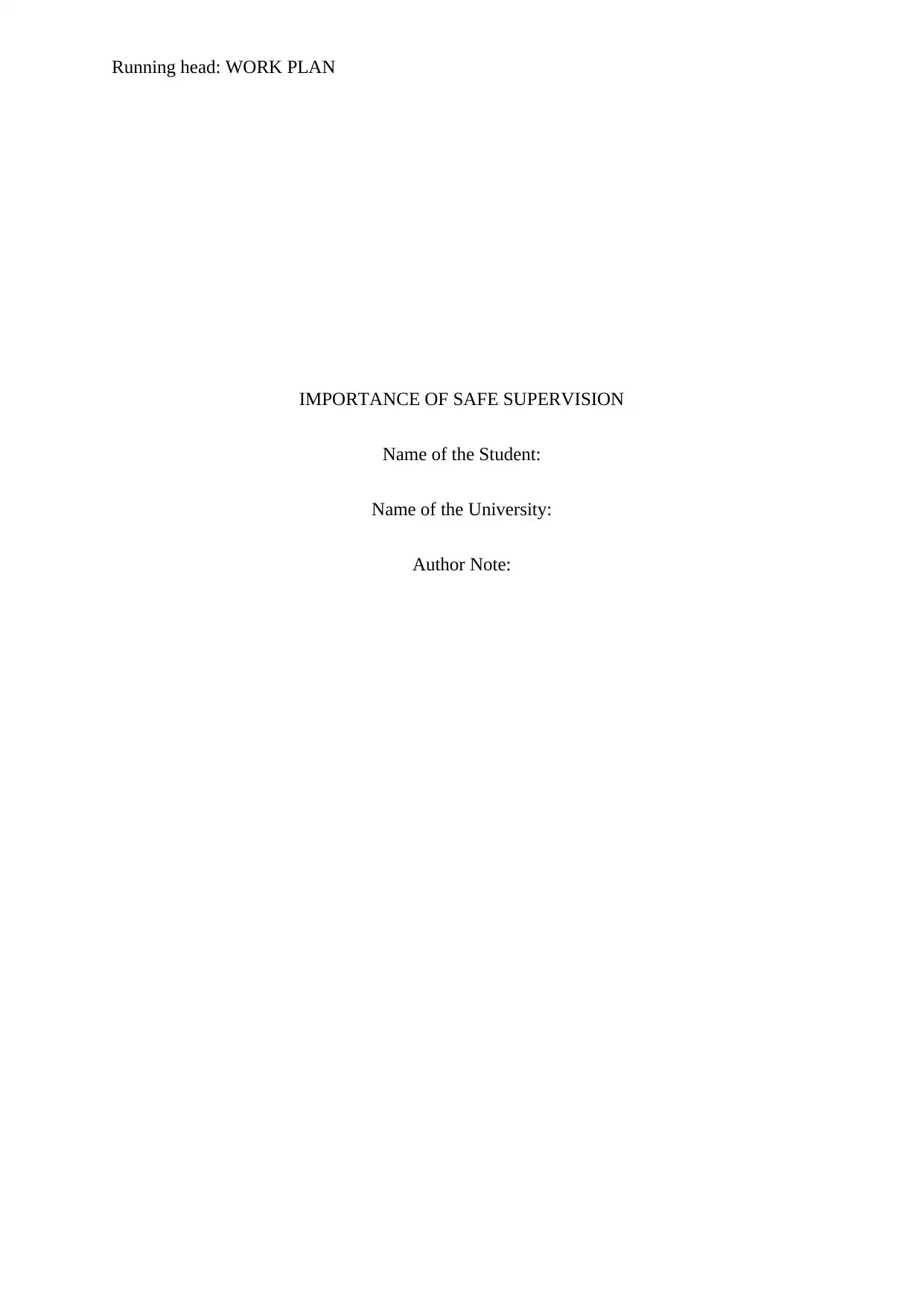
Running head: WORK PLAN
IMPORTANCE OF SAFE SUPERVISION
Name of the Student:
Name of the University:
Author Note:
IMPORTANCE OF SAFE SUPERVISION
Name of the Student:
Name of the University:
Author Note:
Paraphrase This Document
Need a fresh take? Get an instant paraphrase of this document with our AI Paraphraser
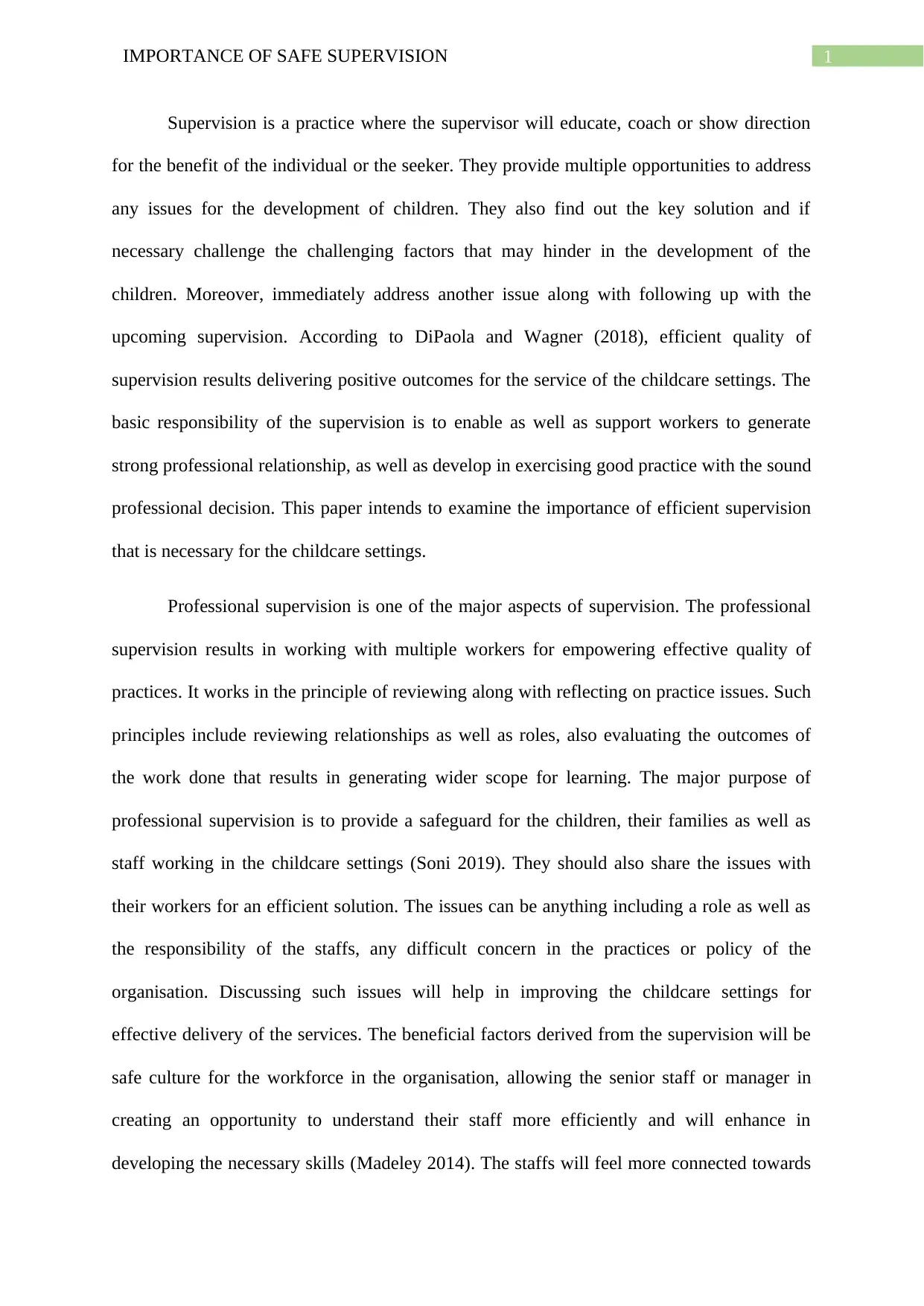
1IMPORTANCE OF SAFE SUPERVISION
Supervision is a practice where the supervisor will educate, coach or show direction
for the benefit of the individual or the seeker. They provide multiple opportunities to address
any issues for the development of children. They also find out the key solution and if
necessary challenge the challenging factors that may hinder in the development of the
children. Moreover, immediately address another issue along with following up with the
upcoming supervision. According to DiPaola and Wagner (2018), efficient quality of
supervision results delivering positive outcomes for the service of the childcare settings. The
basic responsibility of the supervision is to enable as well as support workers to generate
strong professional relationship, as well as develop in exercising good practice with the sound
professional decision. This paper intends to examine the importance of efficient supervision
that is necessary for the childcare settings.
Professional supervision is one of the major aspects of supervision. The professional
supervision results in working with multiple workers for empowering effective quality of
practices. It works in the principle of reviewing along with reflecting on practice issues. Such
principles include reviewing relationships as well as roles, also evaluating the outcomes of
the work done that results in generating wider scope for learning. The major purpose of
professional supervision is to provide a safeguard for the children, their families as well as
staff working in the childcare settings (Soni 2019). They should also share the issues with
their workers for an efficient solution. The issues can be anything including a role as well as
the responsibility of the staffs, any difficult concern in the practices or policy of the
organisation. Discussing such issues will help in improving the childcare settings for
effective delivery of the services. The beneficial factors derived from the supervision will be
safe culture for the workforce in the organisation, allowing the senior staff or manager in
creating an opportunity to understand their staff more efficiently and will enhance in
developing the necessary skills (Madeley 2014). The staffs will feel more connected towards
Supervision is a practice where the supervisor will educate, coach or show direction
for the benefit of the individual or the seeker. They provide multiple opportunities to address
any issues for the development of children. They also find out the key solution and if
necessary challenge the challenging factors that may hinder in the development of the
children. Moreover, immediately address another issue along with following up with the
upcoming supervision. According to DiPaola and Wagner (2018), efficient quality of
supervision results delivering positive outcomes for the service of the childcare settings. The
basic responsibility of the supervision is to enable as well as support workers to generate
strong professional relationship, as well as develop in exercising good practice with the sound
professional decision. This paper intends to examine the importance of efficient supervision
that is necessary for the childcare settings.
Professional supervision is one of the major aspects of supervision. The professional
supervision results in working with multiple workers for empowering effective quality of
practices. It works in the principle of reviewing along with reflecting on practice issues. Such
principles include reviewing relationships as well as roles, also evaluating the outcomes of
the work done that results in generating wider scope for learning. The major purpose of
professional supervision is to provide a safeguard for the children, their families as well as
staff working in the childcare settings (Soni 2019). They should also share the issues with
their workers for an efficient solution. The issues can be anything including a role as well as
the responsibility of the staffs, any difficult concern in the practices or policy of the
organisation. Discussing such issues will help in improving the childcare settings for
effective delivery of the services. The beneficial factors derived from the supervision will be
safe culture for the workforce in the organisation, allowing the senior staff or manager in
creating an opportunity to understand their staff more efficiently and will enhance in
developing the necessary skills (Madeley 2014). The staffs will feel more connected towards
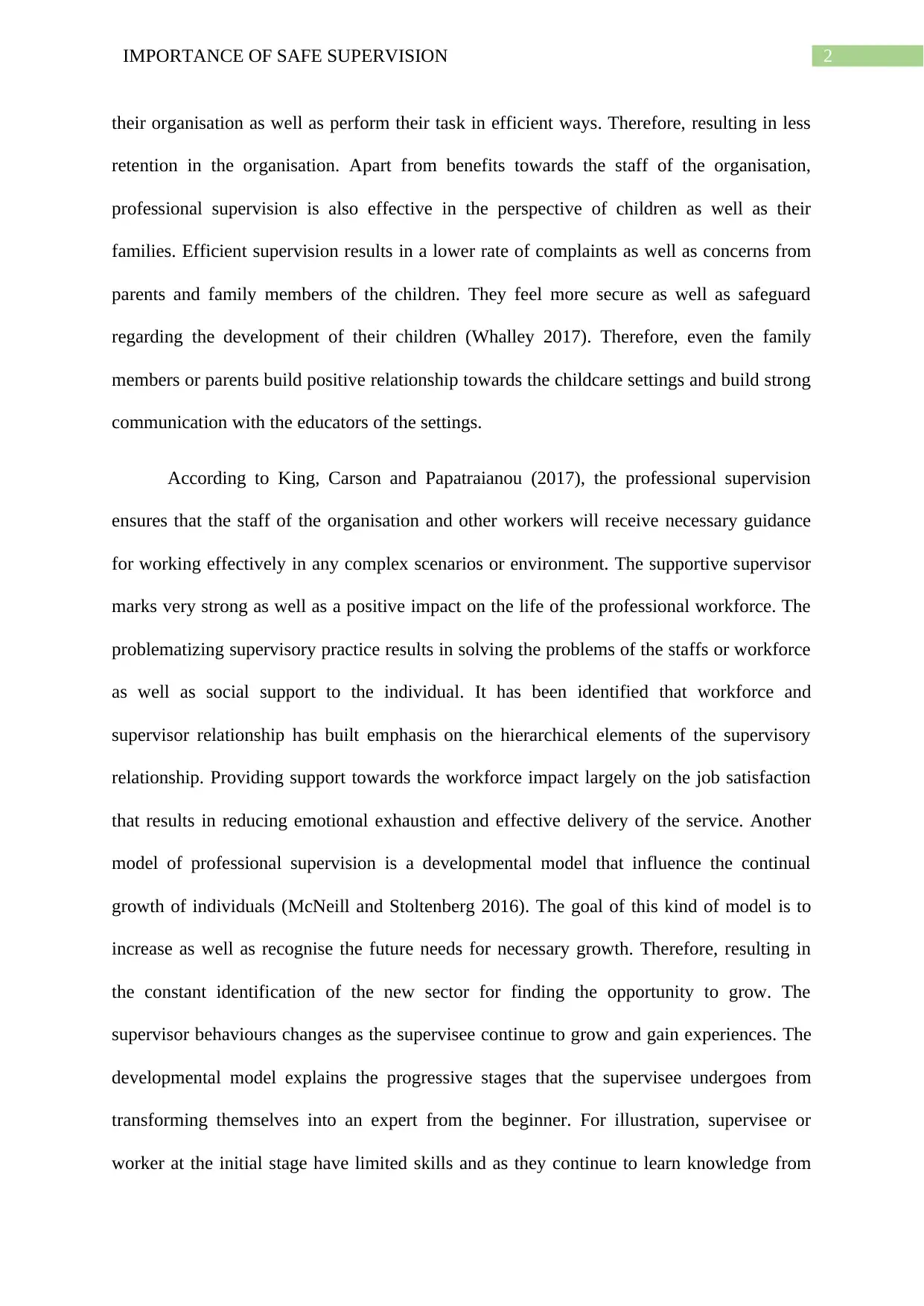
2IMPORTANCE OF SAFE SUPERVISION
their organisation as well as perform their task in efficient ways. Therefore, resulting in less
retention in the organisation. Apart from benefits towards the staff of the organisation,
professional supervision is also effective in the perspective of children as well as their
families. Efficient supervision results in a lower rate of complaints as well as concerns from
parents and family members of the children. They feel more secure as well as safeguard
regarding the development of their children (Whalley 2017). Therefore, even the family
members or parents build positive relationship towards the childcare settings and build strong
communication with the educators of the settings.
According to King, Carson and Papatraianou (2017), the professional supervision
ensures that the staff of the organisation and other workers will receive necessary guidance
for working effectively in any complex scenarios or environment. The supportive supervisor
marks very strong as well as a positive impact on the life of the professional workforce. The
problematizing supervisory practice results in solving the problems of the staffs or workforce
as well as social support to the individual. It has been identified that workforce and
supervisor relationship has built emphasis on the hierarchical elements of the supervisory
relationship. Providing support towards the workforce impact largely on the job satisfaction
that results in reducing emotional exhaustion and effective delivery of the service. Another
model of professional supervision is a developmental model that influence the continual
growth of individuals (McNeill and Stoltenberg 2016). The goal of this kind of model is to
increase as well as recognise the future needs for necessary growth. Therefore, resulting in
the constant identification of the new sector for finding the opportunity to grow. The
supervisor behaviours changes as the supervisee continue to grow and gain experiences. The
developmental model explains the progressive stages that the supervisee undergoes from
transforming themselves into an expert from the beginner. For illustration, supervisee or
worker at the initial stage have limited skills and as they continue to learn knowledge from
their organisation as well as perform their task in efficient ways. Therefore, resulting in less
retention in the organisation. Apart from benefits towards the staff of the organisation,
professional supervision is also effective in the perspective of children as well as their
families. Efficient supervision results in a lower rate of complaints as well as concerns from
parents and family members of the children. They feel more secure as well as safeguard
regarding the development of their children (Whalley 2017). Therefore, even the family
members or parents build positive relationship towards the childcare settings and build strong
communication with the educators of the settings.
According to King, Carson and Papatraianou (2017), the professional supervision
ensures that the staff of the organisation and other workers will receive necessary guidance
for working effectively in any complex scenarios or environment. The supportive supervisor
marks very strong as well as a positive impact on the life of the professional workforce. The
problematizing supervisory practice results in solving the problems of the staffs or workforce
as well as social support to the individual. It has been identified that workforce and
supervisor relationship has built emphasis on the hierarchical elements of the supervisory
relationship. Providing support towards the workforce impact largely on the job satisfaction
that results in reducing emotional exhaustion and effective delivery of the service. Another
model of professional supervision is a developmental model that influence the continual
growth of individuals (McNeill and Stoltenberg 2016). The goal of this kind of model is to
increase as well as recognise the future needs for necessary growth. Therefore, resulting in
the constant identification of the new sector for finding the opportunity to grow. The
supervisor behaviours changes as the supervisee continue to grow and gain experiences. The
developmental model explains the progressive stages that the supervisee undergoes from
transforming themselves into an expert from the beginner. For illustration, supervisee or
worker at the initial stage have limited skills and as they continue to learn knowledge from
⊘ This is a preview!⊘
Do you want full access?
Subscribe today to unlock all pages.

Trusted by 1+ million students worldwide
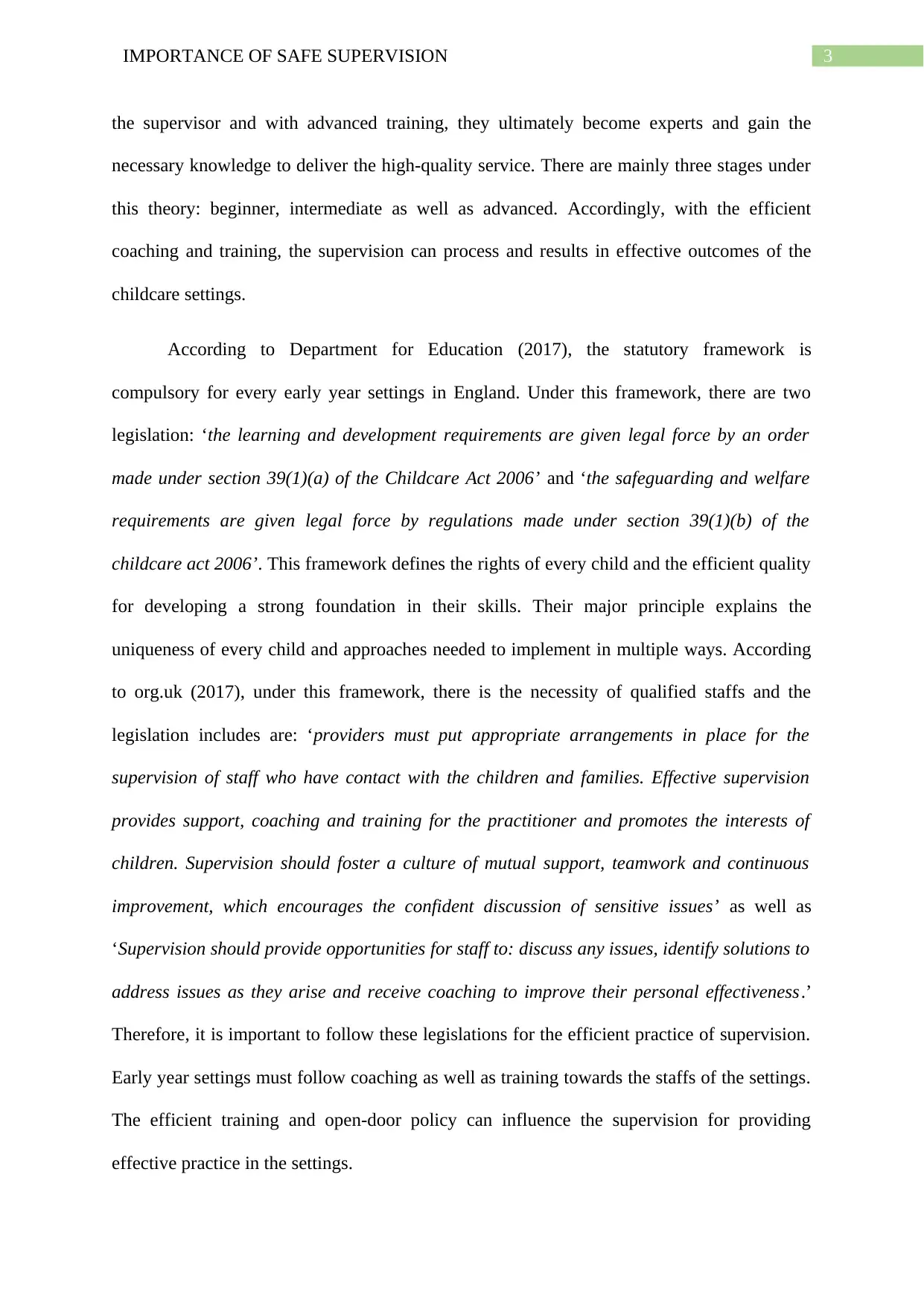
3IMPORTANCE OF SAFE SUPERVISION
the supervisor and with advanced training, they ultimately become experts and gain the
necessary knowledge to deliver the high-quality service. There are mainly three stages under
this theory: beginner, intermediate as well as advanced. Accordingly, with the efficient
coaching and training, the supervision can process and results in effective outcomes of the
childcare settings.
According to Department for Education (2017), the statutory framework is
compulsory for every early year settings in England. Under this framework, there are two
legislation: ‘the learning and development requirements are given legal force by an order
made under section 39(1)(a) of the Childcare Act 2006’ and ‘the safeguarding and welfare
requirements are given legal force by regulations made under section 39(1)(b) of the
childcare act 2006’. This framework defines the rights of every child and the efficient quality
for developing a strong foundation in their skills. Their major principle explains the
uniqueness of every child and approaches needed to implement in multiple ways. According
to org.uk (2017), under this framework, there is the necessity of qualified staffs and the
legislation includes are: ‘providers must put appropriate arrangements in place for the
supervision of staff who have contact with the children and families. Effective supervision
provides support, coaching and training for the practitioner and promotes the interests of
children. Supervision should foster a culture of mutual support, teamwork and continuous
improvement, which encourages the confident discussion of sensitive issues’ as well as
‘Supervision should provide opportunities for staff to: discuss any issues, identify solutions to
address issues as they arise and receive coaching to improve their personal effectiveness.’
Therefore, it is important to follow these legislations for the efficient practice of supervision.
Early year settings must follow coaching as well as training towards the staffs of the settings.
The efficient training and open-door policy can influence the supervision for providing
effective practice in the settings.
the supervisor and with advanced training, they ultimately become experts and gain the
necessary knowledge to deliver the high-quality service. There are mainly three stages under
this theory: beginner, intermediate as well as advanced. Accordingly, with the efficient
coaching and training, the supervision can process and results in effective outcomes of the
childcare settings.
According to Department for Education (2017), the statutory framework is
compulsory for every early year settings in England. Under this framework, there are two
legislation: ‘the learning and development requirements are given legal force by an order
made under section 39(1)(a) of the Childcare Act 2006’ and ‘the safeguarding and welfare
requirements are given legal force by regulations made under section 39(1)(b) of the
childcare act 2006’. This framework defines the rights of every child and the efficient quality
for developing a strong foundation in their skills. Their major principle explains the
uniqueness of every child and approaches needed to implement in multiple ways. According
to org.uk (2017), under this framework, there is the necessity of qualified staffs and the
legislation includes are: ‘providers must put appropriate arrangements in place for the
supervision of staff who have contact with the children and families. Effective supervision
provides support, coaching and training for the practitioner and promotes the interests of
children. Supervision should foster a culture of mutual support, teamwork and continuous
improvement, which encourages the confident discussion of sensitive issues’ as well as
‘Supervision should provide opportunities for staff to: discuss any issues, identify solutions to
address issues as they arise and receive coaching to improve their personal effectiveness.’
Therefore, it is important to follow these legislations for the efficient practice of supervision.
Early year settings must follow coaching as well as training towards the staffs of the settings.
The efficient training and open-door policy can influence the supervision for providing
effective practice in the settings.
Paraphrase This Document
Need a fresh take? Get an instant paraphrase of this document with our AI Paraphraser
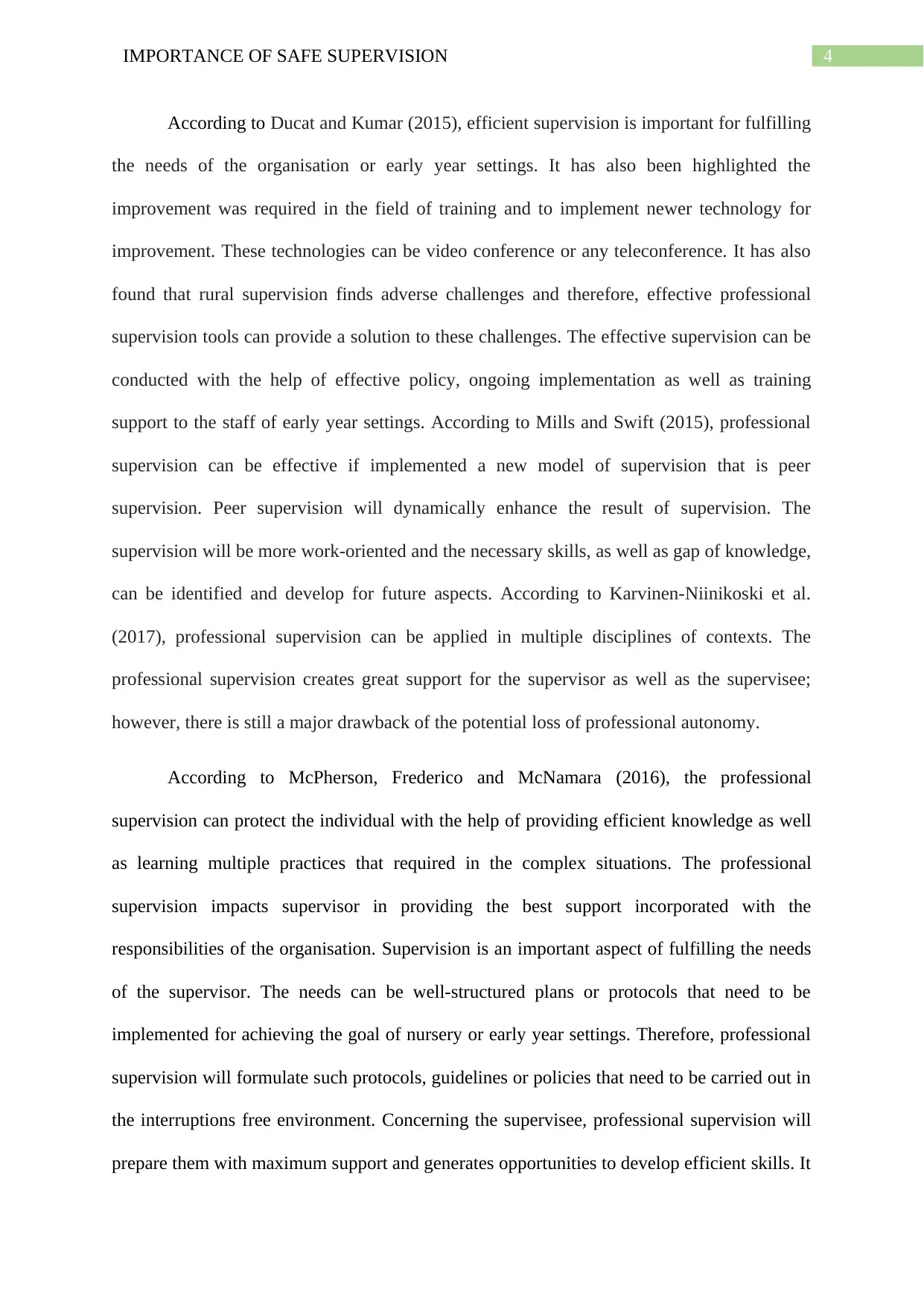
4IMPORTANCE OF SAFE SUPERVISION
According to Ducat and Kumar (2015), efficient supervision is important for fulfilling
the needs of the organisation or early year settings. It has also been highlighted the
improvement was required in the field of training and to implement newer technology for
improvement. These technologies can be video conference or any teleconference. It has also
found that rural supervision finds adverse challenges and therefore, effective professional
supervision tools can provide a solution to these challenges. The effective supervision can be
conducted with the help of effective policy, ongoing implementation as well as training
support to the staff of early year settings. According to Mills and Swift (2015), professional
supervision can be effective if implemented a new model of supervision that is peer
supervision. Peer supervision will dynamically enhance the result of supervision. The
supervision will be more work-oriented and the necessary skills, as well as gap of knowledge,
can be identified and develop for future aspects. According to Karvinen-Niinikoski et al.
(2017), professional supervision can be applied in multiple disciplines of contexts. The
professional supervision creates great support for the supervisor as well as the supervisee;
however, there is still a major drawback of the potential loss of professional autonomy.
According to McPherson, Frederico and McNamara (2016), the professional
supervision can protect the individual with the help of providing efficient knowledge as well
as learning multiple practices that required in the complex situations. The professional
supervision impacts supervisor in providing the best support incorporated with the
responsibilities of the organisation. Supervision is an important aspect of fulfilling the needs
of the supervisor. The needs can be well-structured plans or protocols that need to be
implemented for achieving the goal of nursery or early year settings. Therefore, professional
supervision will formulate such protocols, guidelines or policies that need to be carried out in
the interruptions free environment. Concerning the supervisee, professional supervision will
prepare them with maximum support and generates opportunities to develop efficient skills. It
According to Ducat and Kumar (2015), efficient supervision is important for fulfilling
the needs of the organisation or early year settings. It has also been highlighted the
improvement was required in the field of training and to implement newer technology for
improvement. These technologies can be video conference or any teleconference. It has also
found that rural supervision finds adverse challenges and therefore, effective professional
supervision tools can provide a solution to these challenges. The effective supervision can be
conducted with the help of effective policy, ongoing implementation as well as training
support to the staff of early year settings. According to Mills and Swift (2015), professional
supervision can be effective if implemented a new model of supervision that is peer
supervision. Peer supervision will dynamically enhance the result of supervision. The
supervision will be more work-oriented and the necessary skills, as well as gap of knowledge,
can be identified and develop for future aspects. According to Karvinen-Niinikoski et al.
(2017), professional supervision can be applied in multiple disciplines of contexts. The
professional supervision creates great support for the supervisor as well as the supervisee;
however, there is still a major drawback of the potential loss of professional autonomy.
According to McPherson, Frederico and McNamara (2016), the professional
supervision can protect the individual with the help of providing efficient knowledge as well
as learning multiple practices that required in the complex situations. The professional
supervision impacts supervisor in providing the best support incorporated with the
responsibilities of the organisation. Supervision is an important aspect of fulfilling the needs
of the supervisor. The needs can be well-structured plans or protocols that need to be
implemented for achieving the goal of nursery or early year settings. Therefore, professional
supervision will formulate such protocols, guidelines or policies that need to be carried out in
the interruptions free environment. Concerning the supervisee, professional supervision will
prepare them with maximum support and generates opportunities to develop efficient skills. It
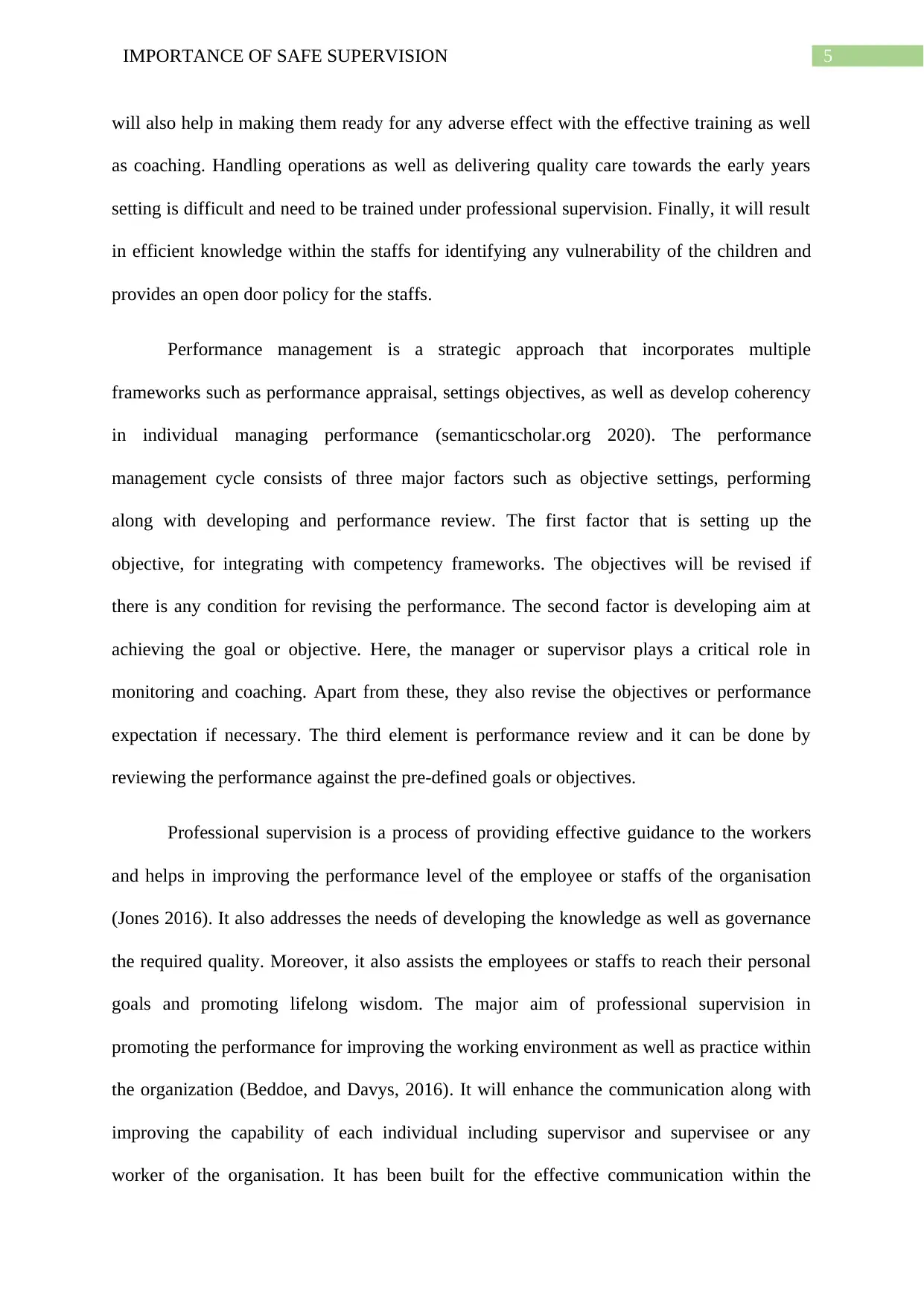
5IMPORTANCE OF SAFE SUPERVISION
will also help in making them ready for any adverse effect with the effective training as well
as coaching. Handling operations as well as delivering quality care towards the early years
setting is difficult and need to be trained under professional supervision. Finally, it will result
in efficient knowledge within the staffs for identifying any vulnerability of the children and
provides an open door policy for the staffs.
Performance management is a strategic approach that incorporates multiple
frameworks such as performance appraisal, settings objectives, as well as develop coherency
in individual managing performance (semanticscholar.org 2020). The performance
management cycle consists of three major factors such as objective settings, performing
along with developing and performance review. The first factor that is setting up the
objective, for integrating with competency frameworks. The objectives will be revised if
there is any condition for revising the performance. The second factor is developing aim at
achieving the goal or objective. Here, the manager or supervisor plays a critical role in
monitoring and coaching. Apart from these, they also revise the objectives or performance
expectation if necessary. The third element is performance review and it can be done by
reviewing the performance against the pre-defined goals or objectives.
Professional supervision is a process of providing effective guidance to the workers
and helps in improving the performance level of the employee or staffs of the organisation
(Jones 2016). It also addresses the needs of developing the knowledge as well as governance
the required quality. Moreover, it also assists the employees or staffs to reach their personal
goals and promoting lifelong wisdom. The major aim of professional supervision in
promoting the performance for improving the working environment as well as practice within
the organization (Beddoe, and Davys, 2016). It will enhance the communication along with
improving the capability of each individual including supervisor and supervisee or any
worker of the organisation. It has been built for the effective communication within the
will also help in making them ready for any adverse effect with the effective training as well
as coaching. Handling operations as well as delivering quality care towards the early years
setting is difficult and need to be trained under professional supervision. Finally, it will result
in efficient knowledge within the staffs for identifying any vulnerability of the children and
provides an open door policy for the staffs.
Performance management is a strategic approach that incorporates multiple
frameworks such as performance appraisal, settings objectives, as well as develop coherency
in individual managing performance (semanticscholar.org 2020). The performance
management cycle consists of three major factors such as objective settings, performing
along with developing and performance review. The first factor that is setting up the
objective, for integrating with competency frameworks. The objectives will be revised if
there is any condition for revising the performance. The second factor is developing aim at
achieving the goal or objective. Here, the manager or supervisor plays a critical role in
monitoring and coaching. Apart from these, they also revise the objectives or performance
expectation if necessary. The third element is performance review and it can be done by
reviewing the performance against the pre-defined goals or objectives.
Professional supervision is a process of providing effective guidance to the workers
and helps in improving the performance level of the employee or staffs of the organisation
(Jones 2016). It also addresses the needs of developing the knowledge as well as governance
the required quality. Moreover, it also assists the employees or staffs to reach their personal
goals and promoting lifelong wisdom. The major aim of professional supervision in
promoting the performance for improving the working environment as well as practice within
the organization (Beddoe, and Davys, 2016). It will enhance the communication along with
improving the capability of each individual including supervisor and supervisee or any
worker of the organisation. It has been built for the effective communication within the
⊘ This is a preview!⊘
Do you want full access?
Subscribe today to unlock all pages.

Trusted by 1+ million students worldwide
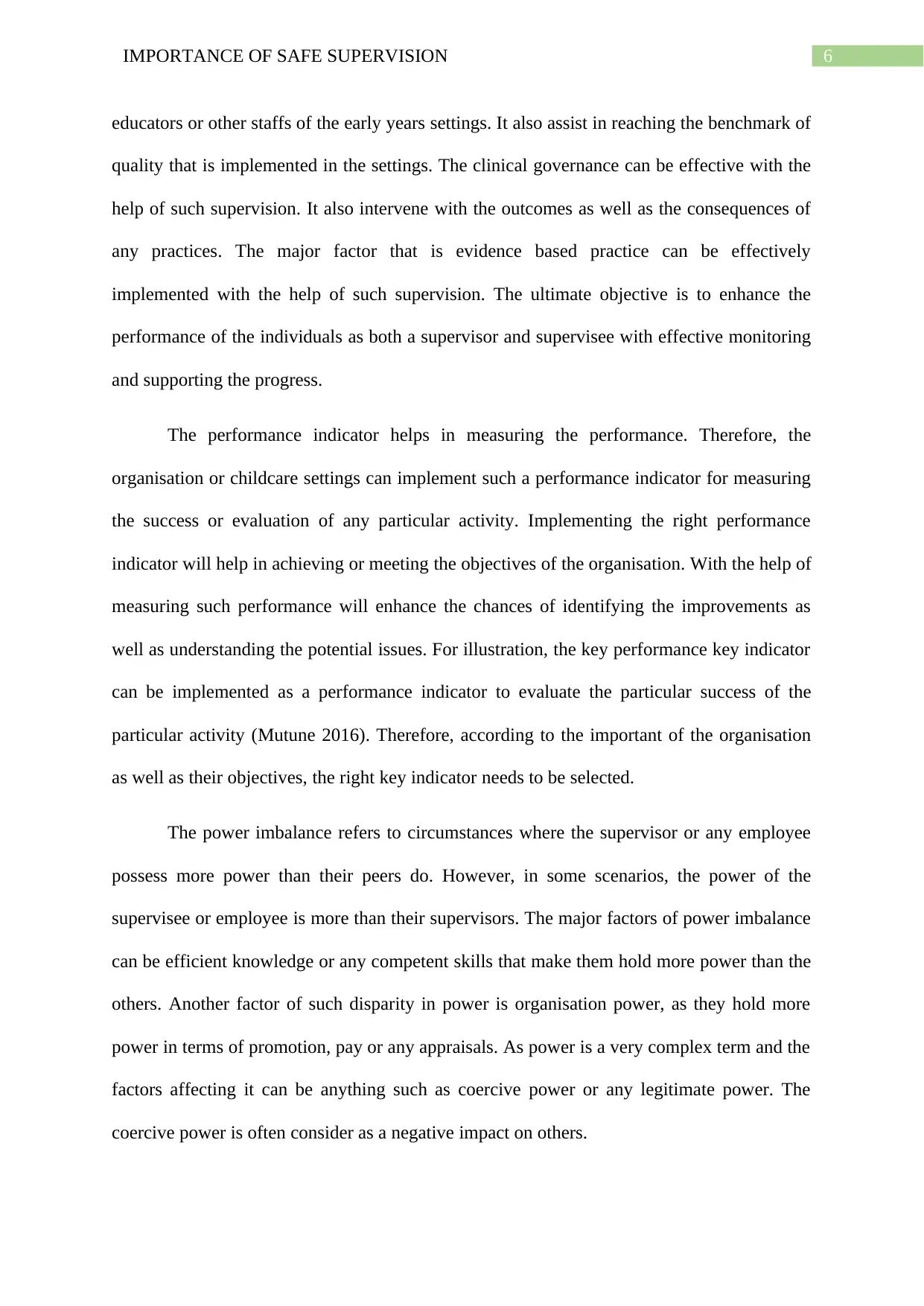
6IMPORTANCE OF SAFE SUPERVISION
educators or other staffs of the early years settings. It also assist in reaching the benchmark of
quality that is implemented in the settings. The clinical governance can be effective with the
help of such supervision. It also intervene with the outcomes as well as the consequences of
any practices. The major factor that is evidence based practice can be effectively
implemented with the help of such supervision. The ultimate objective is to enhance the
performance of the individuals as both a supervisor and supervisee with effective monitoring
and supporting the progress.
The performance indicator helps in measuring the performance. Therefore, the
organisation or childcare settings can implement such a performance indicator for measuring
the success or evaluation of any particular activity. Implementing the right performance
indicator will help in achieving or meeting the objectives of the organisation. With the help of
measuring such performance will enhance the chances of identifying the improvements as
well as understanding the potential issues. For illustration, the key performance key indicator
can be implemented as a performance indicator to evaluate the particular success of the
particular activity (Mutune 2016). Therefore, according to the important of the organisation
as well as their objectives, the right key indicator needs to be selected.
The power imbalance refers to circumstances where the supervisor or any employee
possess more power than their peers do. However, in some scenarios, the power of the
supervisee or employee is more than their supervisors. The major factors of power imbalance
can be efficient knowledge or any competent skills that make them hold more power than the
others. Another factor of such disparity in power is organisation power, as they hold more
power in terms of promotion, pay or any appraisals. As power is a very complex term and the
factors affecting it can be anything such as coercive power or any legitimate power. The
coercive power is often consider as a negative impact on others.
educators or other staffs of the early years settings. It also assist in reaching the benchmark of
quality that is implemented in the settings. The clinical governance can be effective with the
help of such supervision. It also intervene with the outcomes as well as the consequences of
any practices. The major factor that is evidence based practice can be effectively
implemented with the help of such supervision. The ultimate objective is to enhance the
performance of the individuals as both a supervisor and supervisee with effective monitoring
and supporting the progress.
The performance indicator helps in measuring the performance. Therefore, the
organisation or childcare settings can implement such a performance indicator for measuring
the success or evaluation of any particular activity. Implementing the right performance
indicator will help in achieving or meeting the objectives of the organisation. With the help of
measuring such performance will enhance the chances of identifying the improvements as
well as understanding the potential issues. For illustration, the key performance key indicator
can be implemented as a performance indicator to evaluate the particular success of the
particular activity (Mutune 2016). Therefore, according to the important of the organisation
as well as their objectives, the right key indicator needs to be selected.
The power imbalance refers to circumstances where the supervisor or any employee
possess more power than their peers do. However, in some scenarios, the power of the
supervisee or employee is more than their supervisors. The major factors of power imbalance
can be efficient knowledge or any competent skills that make them hold more power than the
others. Another factor of such disparity in power is organisation power, as they hold more
power in terms of promotion, pay or any appraisals. As power is a very complex term and the
factors affecting it can be anything such as coercive power or any legitimate power. The
coercive power is often consider as a negative impact on others.
Paraphrase This Document
Need a fresh take? Get an instant paraphrase of this document with our AI Paraphraser
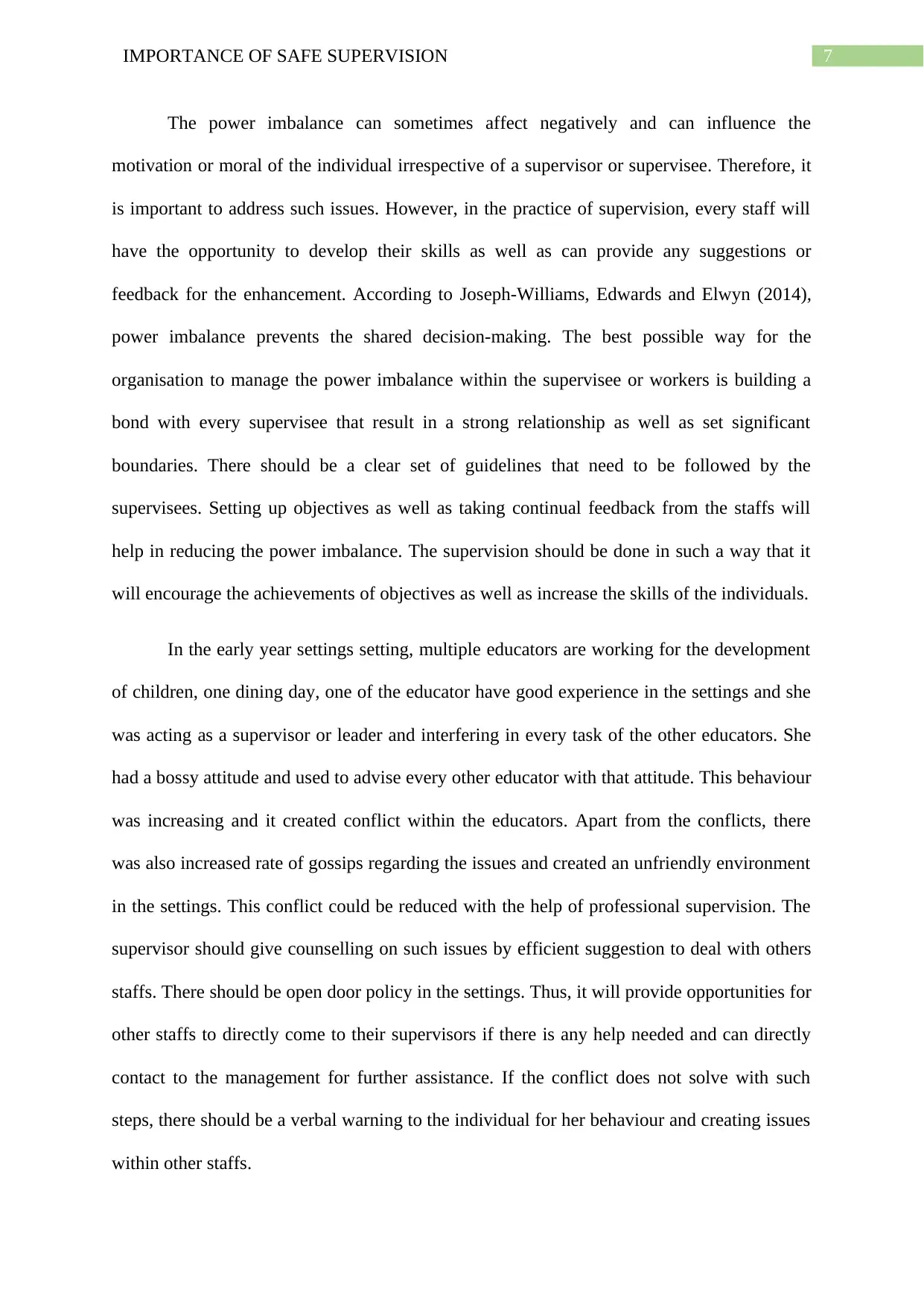
7IMPORTANCE OF SAFE SUPERVISION
The power imbalance can sometimes affect negatively and can influence the
motivation or moral of the individual irrespective of a supervisor or supervisee. Therefore, it
is important to address such issues. However, in the practice of supervision, every staff will
have the opportunity to develop their skills as well as can provide any suggestions or
feedback for the enhancement. According to Joseph-Williams, Edwards and Elwyn (2014),
power imbalance prevents the shared decision-making. The best possible way for the
organisation to manage the power imbalance within the supervisee or workers is building a
bond with every supervisee that result in a strong relationship as well as set significant
boundaries. There should be a clear set of guidelines that need to be followed by the
supervisees. Setting up objectives as well as taking continual feedback from the staffs will
help in reducing the power imbalance. The supervision should be done in such a way that it
will encourage the achievements of objectives as well as increase the skills of the individuals.
In the early year settings setting, multiple educators are working for the development
of children, one dining day, one of the educator have good experience in the settings and she
was acting as a supervisor or leader and interfering in every task of the other educators. She
had a bossy attitude and used to advise every other educator with that attitude. This behaviour
was increasing and it created conflict within the educators. Apart from the conflicts, there
was also increased rate of gossips regarding the issues and created an unfriendly environment
in the settings. This conflict could be reduced with the help of professional supervision. The
supervisor should give counselling on such issues by efficient suggestion to deal with others
staffs. There should be open door policy in the settings. Thus, it will provide opportunities for
other staffs to directly come to their supervisors if there is any help needed and can directly
contact to the management for further assistance. If the conflict does not solve with such
steps, there should be a verbal warning to the individual for her behaviour and creating issues
within other staffs.
The power imbalance can sometimes affect negatively and can influence the
motivation or moral of the individual irrespective of a supervisor or supervisee. Therefore, it
is important to address such issues. However, in the practice of supervision, every staff will
have the opportunity to develop their skills as well as can provide any suggestions or
feedback for the enhancement. According to Joseph-Williams, Edwards and Elwyn (2014),
power imbalance prevents the shared decision-making. The best possible way for the
organisation to manage the power imbalance within the supervisee or workers is building a
bond with every supervisee that result in a strong relationship as well as set significant
boundaries. There should be a clear set of guidelines that need to be followed by the
supervisees. Setting up objectives as well as taking continual feedback from the staffs will
help in reducing the power imbalance. The supervision should be done in such a way that it
will encourage the achievements of objectives as well as increase the skills of the individuals.
In the early year settings setting, multiple educators are working for the development
of children, one dining day, one of the educator have good experience in the settings and she
was acting as a supervisor or leader and interfering in every task of the other educators. She
had a bossy attitude and used to advise every other educator with that attitude. This behaviour
was increasing and it created conflict within the educators. Apart from the conflicts, there
was also increased rate of gossips regarding the issues and created an unfriendly environment
in the settings. This conflict could be reduced with the help of professional supervision. The
supervisor should give counselling on such issues by efficient suggestion to deal with others
staffs. There should be open door policy in the settings. Thus, it will provide opportunities for
other staffs to directly come to their supervisors if there is any help needed and can directly
contact to the management for further assistance. If the conflict does not solve with such
steps, there should be a verbal warning to the individual for her behaviour and creating issues
within other staffs.
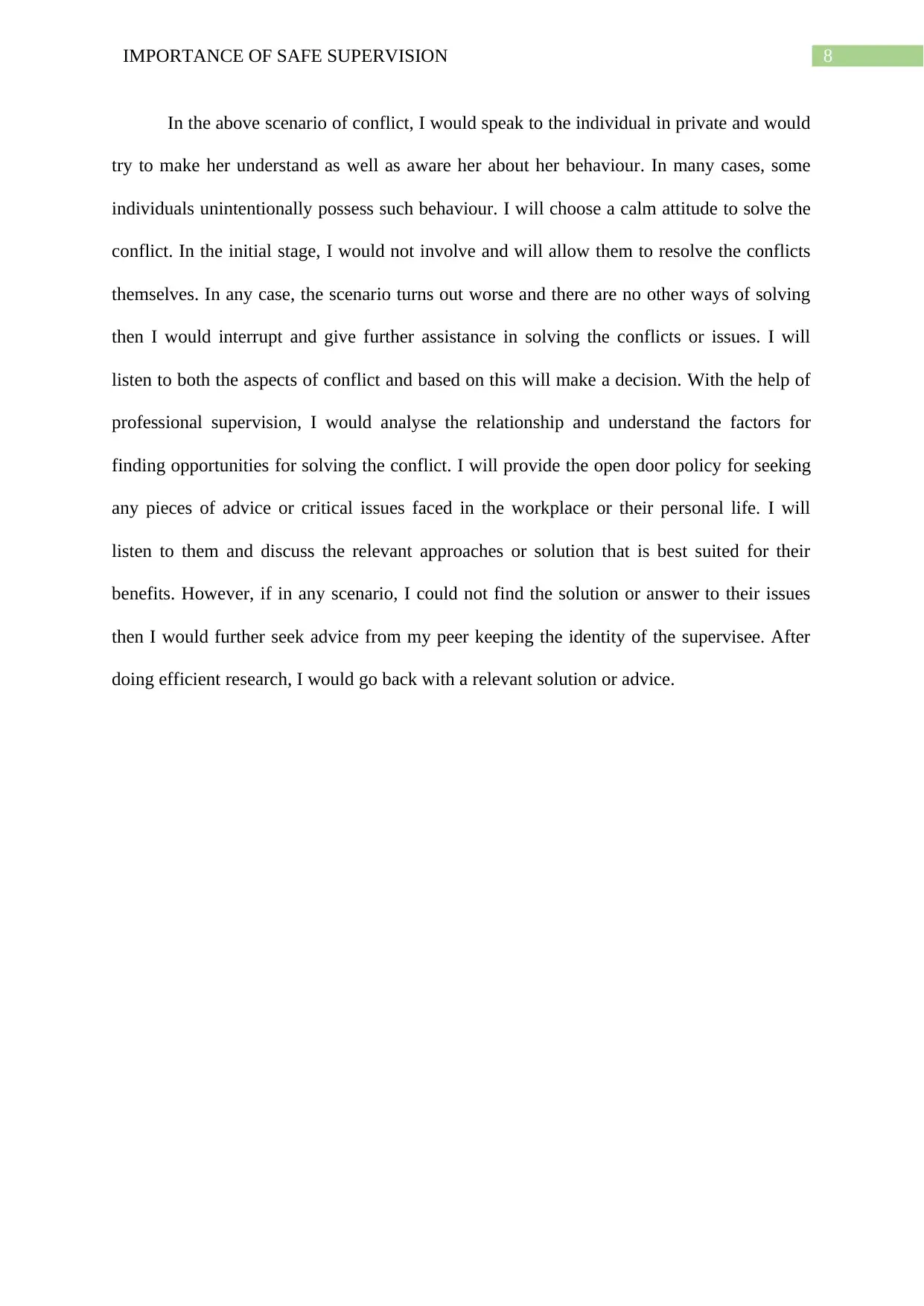
8IMPORTANCE OF SAFE SUPERVISION
In the above scenario of conflict, I would speak to the individual in private and would
try to make her understand as well as aware her about her behaviour. In many cases, some
individuals unintentionally possess such behaviour. I will choose a calm attitude to solve the
conflict. In the initial stage, I would not involve and will allow them to resolve the conflicts
themselves. In any case, the scenario turns out worse and there are no other ways of solving
then I would interrupt and give further assistance in solving the conflicts or issues. I will
listen to both the aspects of conflict and based on this will make a decision. With the help of
professional supervision, I would analyse the relationship and understand the factors for
finding opportunities for solving the conflict. I will provide the open door policy for seeking
any pieces of advice or critical issues faced in the workplace or their personal life. I will
listen to them and discuss the relevant approaches or solution that is best suited for their
benefits. However, if in any scenario, I could not find the solution or answer to their issues
then I would further seek advice from my peer keeping the identity of the supervisee. After
doing efficient research, I would go back with a relevant solution or advice.
In the above scenario of conflict, I would speak to the individual in private and would
try to make her understand as well as aware her about her behaviour. In many cases, some
individuals unintentionally possess such behaviour. I will choose a calm attitude to solve the
conflict. In the initial stage, I would not involve and will allow them to resolve the conflicts
themselves. In any case, the scenario turns out worse and there are no other ways of solving
then I would interrupt and give further assistance in solving the conflicts or issues. I will
listen to both the aspects of conflict and based on this will make a decision. With the help of
professional supervision, I would analyse the relationship and understand the factors for
finding opportunities for solving the conflict. I will provide the open door policy for seeking
any pieces of advice or critical issues faced in the workplace or their personal life. I will
listen to them and discuss the relevant approaches or solution that is best suited for their
benefits. However, if in any scenario, I could not find the solution or answer to their issues
then I would further seek advice from my peer keeping the identity of the supervisee. After
doing efficient research, I would go back with a relevant solution or advice.
⊘ This is a preview!⊘
Do you want full access?
Subscribe today to unlock all pages.

Trusted by 1+ million students worldwide
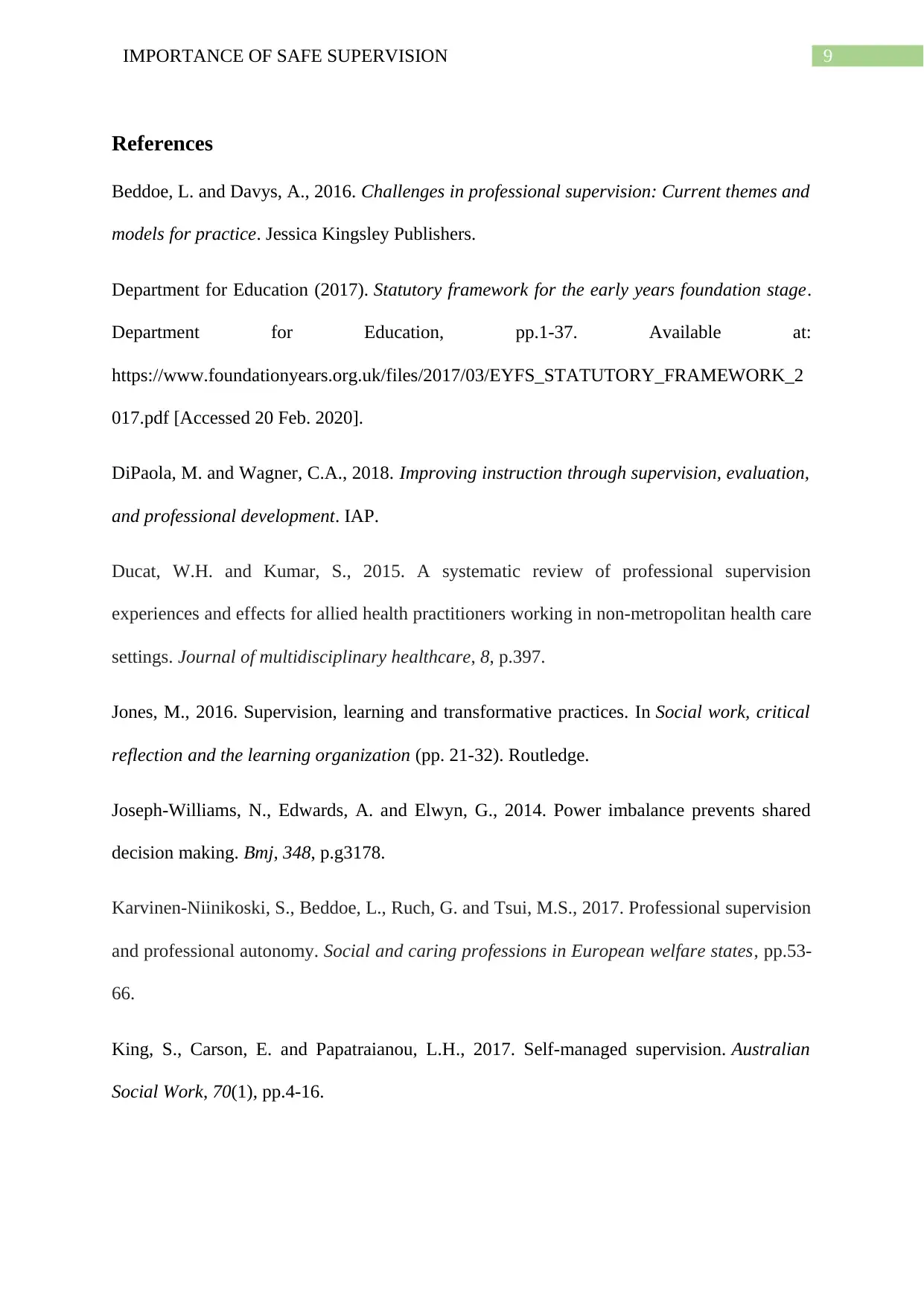
9IMPORTANCE OF SAFE SUPERVISION
References
Beddoe, L. and Davys, A., 2016. Challenges in professional supervision: Current themes and
models for practice. Jessica Kingsley Publishers.
Department for Education (2017). Statutory framework for the early years foundation stage.
Department for Education, pp.1-37. Available at:
https://www.foundationyears.org.uk/files/2017/03/EYFS_STATUTORY_FRAMEWORK_2
017.pdf [Accessed 20 Feb. 2020].
DiPaola, M. and Wagner, C.A., 2018. Improving instruction through supervision, evaluation,
and professional development. IAP.
Ducat, W.H. and Kumar, S., 2015. A systematic review of professional supervision
experiences and effects for allied health practitioners working in non-metropolitan health care
settings. Journal of multidisciplinary healthcare, 8, p.397.
Jones, M., 2016. Supervision, learning and transformative practices. In Social work, critical
reflection and the learning organization (pp. 21-32). Routledge.
Joseph-Williams, N., Edwards, A. and Elwyn, G., 2014. Power imbalance prevents shared
decision making. Bmj, 348, p.g3178.
Karvinen-Niinikoski, S., Beddoe, L., Ruch, G. and Tsui, M.S., 2017. Professional supervision
and professional autonomy. Social and caring professions in European welfare states, pp.53-
66.
King, S., Carson, E. and Papatraianou, L.H., 2017. Self-managed supervision. Australian
Social Work, 70(1), pp.4-16.
References
Beddoe, L. and Davys, A., 2016. Challenges in professional supervision: Current themes and
models for practice. Jessica Kingsley Publishers.
Department for Education (2017). Statutory framework for the early years foundation stage.
Department for Education, pp.1-37. Available at:
https://www.foundationyears.org.uk/files/2017/03/EYFS_STATUTORY_FRAMEWORK_2
017.pdf [Accessed 20 Feb. 2020].
DiPaola, M. and Wagner, C.A., 2018. Improving instruction through supervision, evaluation,
and professional development. IAP.
Ducat, W.H. and Kumar, S., 2015. A systematic review of professional supervision
experiences and effects for allied health practitioners working in non-metropolitan health care
settings. Journal of multidisciplinary healthcare, 8, p.397.
Jones, M., 2016. Supervision, learning and transformative practices. In Social work, critical
reflection and the learning organization (pp. 21-32). Routledge.
Joseph-Williams, N., Edwards, A. and Elwyn, G., 2014. Power imbalance prevents shared
decision making. Bmj, 348, p.g3178.
Karvinen-Niinikoski, S., Beddoe, L., Ruch, G. and Tsui, M.S., 2017. Professional supervision
and professional autonomy. Social and caring professions in European welfare states, pp.53-
66.
King, S., Carson, E. and Papatraianou, L.H., 2017. Self-managed supervision. Australian
Social Work, 70(1), pp.4-16.
Paraphrase This Document
Need a fresh take? Get an instant paraphrase of this document with our AI Paraphraser
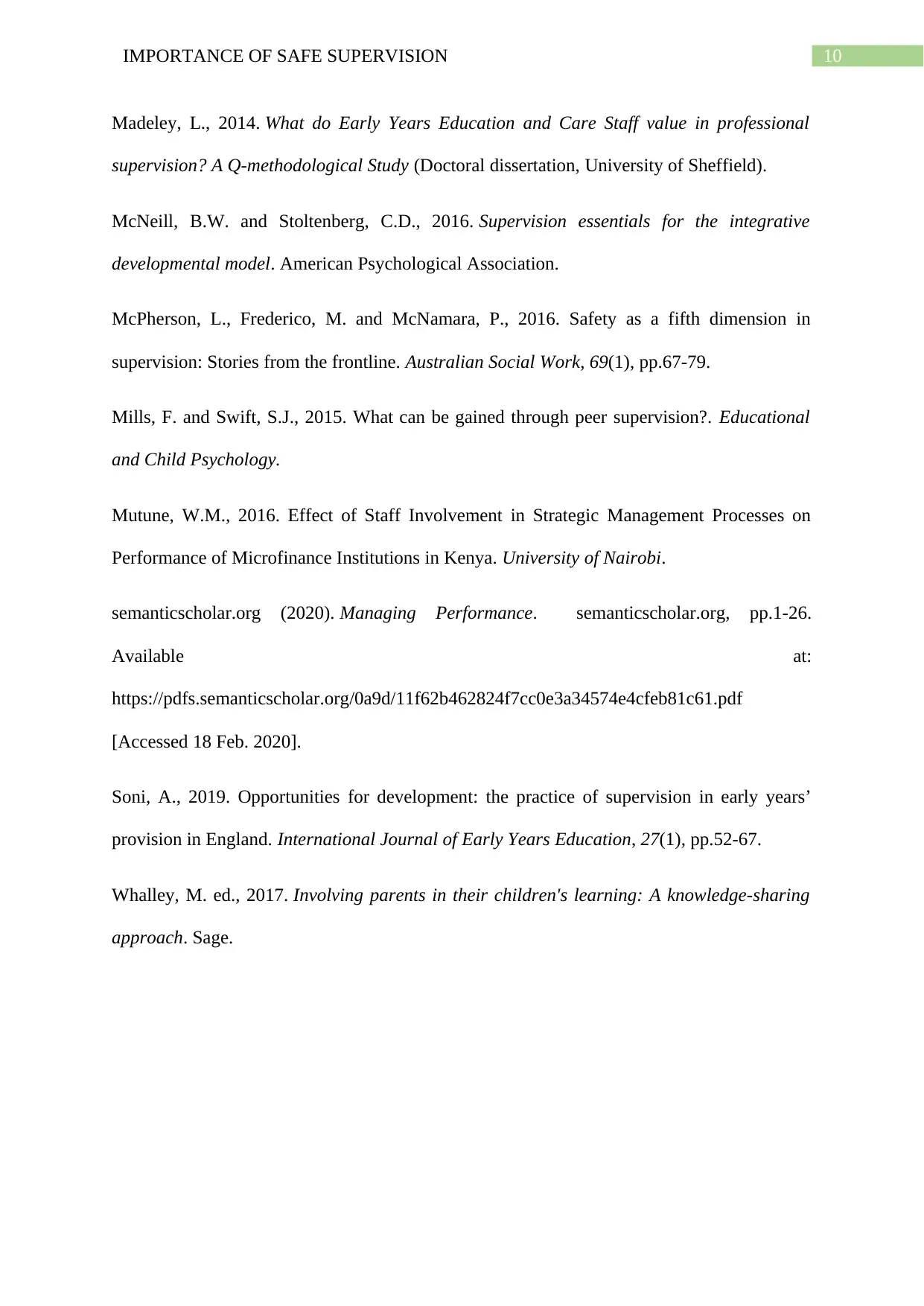
10IMPORTANCE OF SAFE SUPERVISION
Madeley, L., 2014. What do Early Years Education and Care Staff value in professional
supervision? A Q-methodological Study (Doctoral dissertation, University of Sheffield).
McNeill, B.W. and Stoltenberg, C.D., 2016. Supervision essentials for the integrative
developmental model. American Psychological Association.
McPherson, L., Frederico, M. and McNamara, P., 2016. Safety as a fifth dimension in
supervision: Stories from the frontline. Australian Social Work, 69(1), pp.67-79.
Mills, F. and Swift, S.J., 2015. What can be gained through peer supervision?. Educational
and Child Psychology.
Mutune, W.M., 2016. Effect of Staff Involvement in Strategic Management Processes on
Performance of Microfinance Institutions in Kenya. University of Nairobi.
semanticscholar.org (2020). Managing Performance. semanticscholar.org, pp.1-26.
Available at:
https://pdfs.semanticscholar.org/0a9d/11f62b462824f7cc0e3a34574e4cfeb81c61.pdf
[Accessed 18 Feb. 2020].
Soni, A., 2019. Opportunities for development: the practice of supervision in early years’
provision in England. International Journal of Early Years Education, 27(1), pp.52-67.
Whalley, M. ed., 2017. Involving parents in their children's learning: A knowledge-sharing
approach. Sage.
Madeley, L., 2014. What do Early Years Education and Care Staff value in professional
supervision? A Q-methodological Study (Doctoral dissertation, University of Sheffield).
McNeill, B.W. and Stoltenberg, C.D., 2016. Supervision essentials for the integrative
developmental model. American Psychological Association.
McPherson, L., Frederico, M. and McNamara, P., 2016. Safety as a fifth dimension in
supervision: Stories from the frontline. Australian Social Work, 69(1), pp.67-79.
Mills, F. and Swift, S.J., 2015. What can be gained through peer supervision?. Educational
and Child Psychology.
Mutune, W.M., 2016. Effect of Staff Involvement in Strategic Management Processes on
Performance of Microfinance Institutions in Kenya. University of Nairobi.
semanticscholar.org (2020). Managing Performance. semanticscholar.org, pp.1-26.
Available at:
https://pdfs.semanticscholar.org/0a9d/11f62b462824f7cc0e3a34574e4cfeb81c61.pdf
[Accessed 18 Feb. 2020].
Soni, A., 2019. Opportunities for development: the practice of supervision in early years’
provision in England. International Journal of Early Years Education, 27(1), pp.52-67.
Whalley, M. ed., 2017. Involving parents in their children's learning: A knowledge-sharing
approach. Sage.
1 out of 11
Related Documents
Your All-in-One AI-Powered Toolkit for Academic Success.
+13062052269
info@desklib.com
Available 24*7 on WhatsApp / Email
![[object Object]](/_next/static/media/star-bottom.7253800d.svg)
Unlock your academic potential
Copyright © 2020–2025 A2Z Services. All Rights Reserved. Developed and managed by ZUCOL.





